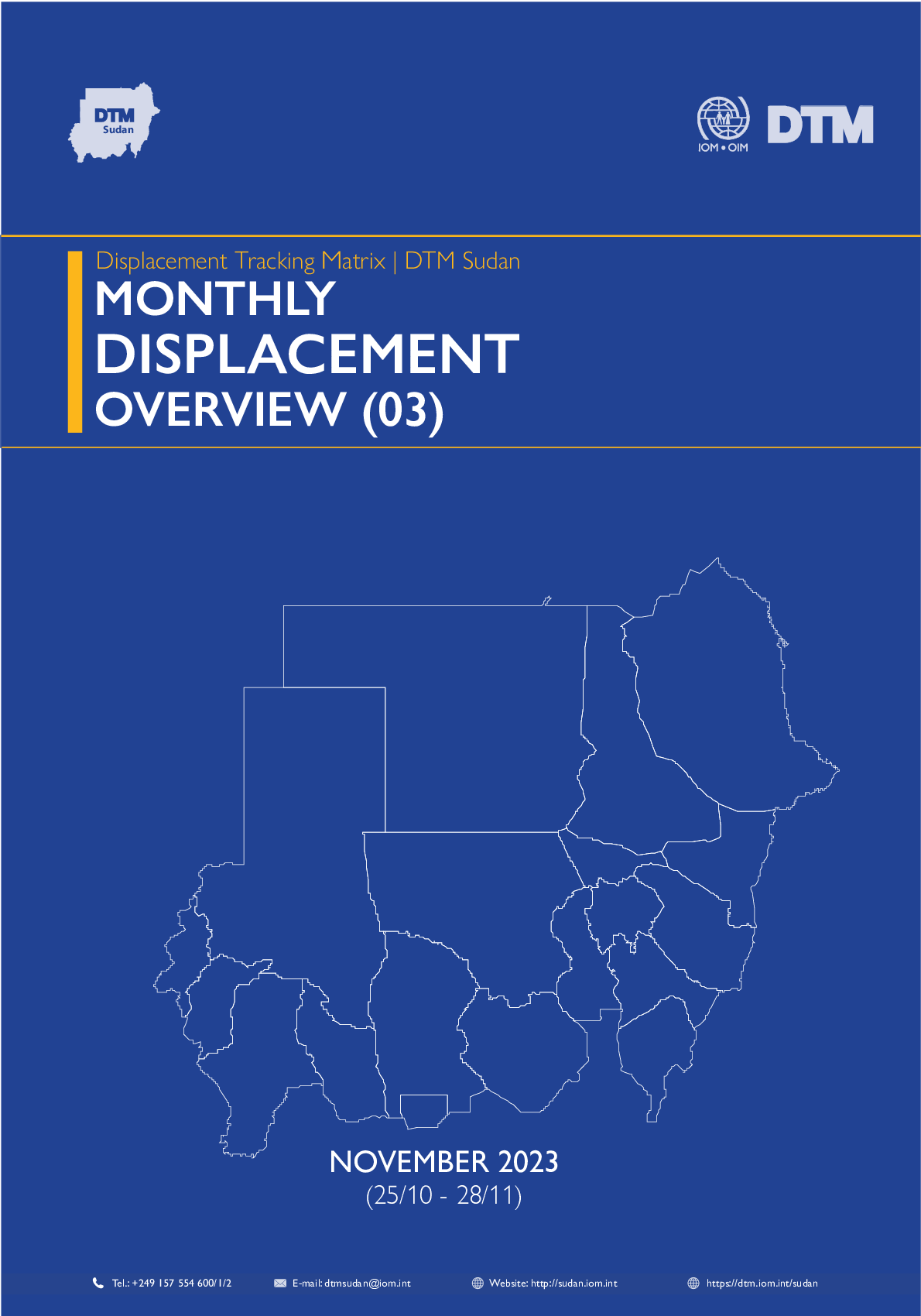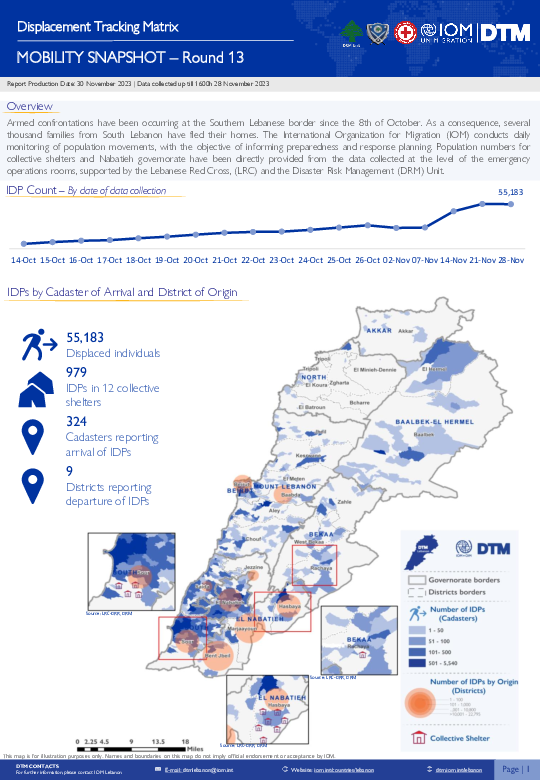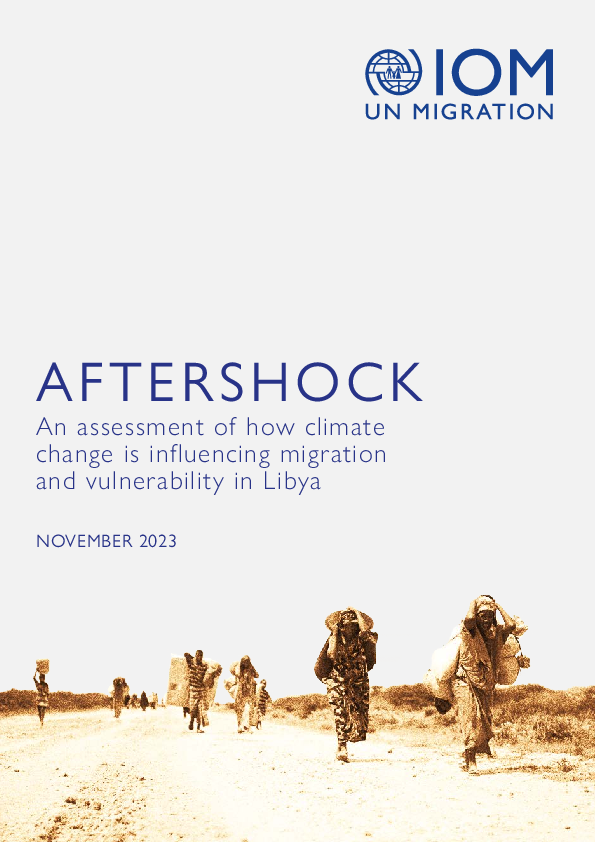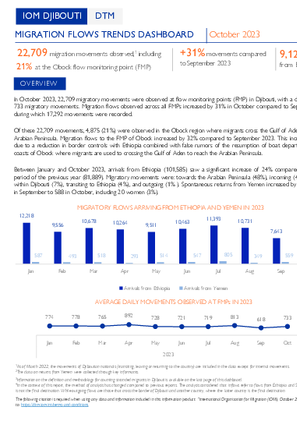-
Countries
-
Data and Analysis
-
Special Focus
-
Crisis Responses
Assessment Report

Contact
DTM Europe, DTMMediterranean@iom.int
Language
English
Location
Hungary
Period Covered
Jul 01 2023
Sep 30 2023
Activity
- Survey
- Return Intention
Key Findings:
- Top 3 countries of stay: Hungary (63%), Germany (12%), Austria (5%).
- Top oblasts of origin: Kyiv (24%), Zakarpatska (18%), Dnipropetrovska (14%).
- Destinations in Ukraine: returning to oblast of origin (85%), returning to a different oblast (14%). Among those intending to return to a different oblast, top intended destinations included: Zakarpatska (68%), Kyiv city (21%), and Lvivska (6.5%).
- Most frequent mode of transport: train (86%).
- Intentions upon crossing back: long-term stay (over 30 days) - 23%, short-term visit (60%), does not know (17%).
- Top needs upon crossing back*: financial support (39%), accommodation (39%), transport (35%).
- Top areas of assistance received*: transport (67%), accommodation (46%), food (37%).
- About 3.7 million people were internally displaced in Ukraine as of September 2023 (IOM Ukraine GPS14 report) and about 5.8 million refugees were recorded across Europe as of end of October 2023 (UNHCR). As of September 2023, almost 4.6 million persons were estimated to be returnees in Ukraine after a period of previous displacement; of them, about 25 per cent (or 1.1 million) were returnees from abroad (IOM Ukraine GPS14 report).
- The number of total border crossings from Ukraine into neighbouring countries from February 2022 until October 2023 reached about 26 million, and at the same time about 18.9 million border crossings were registered in the opposite direction by Ukraine’s border authorities. While some persons returning to Ukraine from abroad intend to remain, others may be engaging in short visits to Ukraine or pendular movements between border areas for a variety of reasons.
- This report presents evidence on persons crossing back to Ukraine from abroad distinguishing between those who aim to remain in Ukraine for longer periods (prospective returnees) and those who plan to pay a short visit (short-time visitors). It is based on 8,563 surveys collected by DTM between July and September 2023 with adult individuals going to Ukraine. About 98 per cent of them were Ukrainians, and 2 per cent Third-Country Nationals (TCNs).
- Sections 2 to 7 focus on the 8,226 surveys with Ukrainian nationals met at the border areas of neighbouring countries to Ukraine: Hungary (333), Poland (925), Republic of Moldova (2,855), Romania (1,589), and Slovakia (2,524). Results are weighted for the number of border crossings into Ukraine from each country during the data collection period. In Section 8, evidence on persons interviewed while crossing back is complemented with data on returnees from abroad collected by DTM in Ukraine.
- The report also discusses the different profiles of Ukrainian nationals surveyed in Latvia (224) while crossing to the Russian Federation with the aim to reach areas of Ukraine which are under the temporary military control of the Russian Federation (Section 9). Additionally, it contains a section dedicated to TCNs crossing into Ukraine from abroad (113 interviews, Section 10). The report ends with a short section elaborating on the Methodology.

Contact
DTM Sudan, DTMSudan@iom.int
Language
English
Location
Sudan
Period Covered
Oct 25 2023
Nov 28 2023
Activity
- Mobility Tracking
- Baseline Assessment
Overview
IOM DTM Sudan presents its third Monthly Displacement Overview. This publication provides an account of Sudan’s displacement context since 15 April 2023 – outlining population caseloads and movements, as well the present and evolving needs of Sudan’s growing IDP caseload.
Rationale
Recognizing the need for more detailed insights into the IDP situation, including the priority needs, access to services, movement intentions, and demographic breakdowns of the affected population, DTM Sudan has undertaken a comprehensive review of our data collection tool. In collaboration with a wide range of internal and external stakeholders, we have developed a new tool to better inform humanitarian response operations, aligning with the DTM global methodology. Leveraging our extensive network of approximately 360 field-based enumerators and a robust system of over 1500 key informants across the country, DTM has gathered data on IDPs across 5,034 locations, in 168 of Sudan’s 189 localities – across all of Sudan’s 18 states.
Key Findings
- DTM Sudan estimates that 5,293,622 Individuals (1,053,712 Households) have been recently internally displaced.
- IOM DTM also reports that an estimated 1,418,255 mixed cross-border movements have been made into neighbouring countries.
- Since 15 April 2023, 47% of the IDP caseload has sought refuge in the Darfur and Kordofan regions, whereas the 53 per cent were observed across the Northern, Eastern, and Central states.
- The majority of the IDP caseload (64%) were seeking shelter with the host community.
- While food security remains the highest priority need, Health and Non-Food Items are also growing concerns.

Contact
dtmlebanon@iom.int
Language
English
Location
Lebanon
Period Covered
Oct 10 2023
Nov 28 2023
Activity
- Mobility Tracking
- Baseline Assessment
Since October 8 there has been an increase in cross-border incidents between Israel and Lebanon, resulting in the displacement of people both within the South and elsewhere within the country. Since October 10, the Displacement Tracking Matrix (DTM) has been conducting the daily monitoring of population movements. The objective of the exercise is to inform preparedness and response planning.

Contact
DTMLibya@iom.int
Language
English
Location
Libya
Snapshot Date
Nov 30 2023
Activity
- Other
This study is based on data collected through interviews with 3,418 migrants held in September and October 2023 in Libya. It shows how climate change acts as a threat multiplier, exacerbating the vulnerabilities of migrants in their countries of origin and in Libya. The data suggests that climate-related events are indirect migration drivers through their negative impact on local economies and workers, particularly those reliant on agriculture. A quarter of migrants interviewed had experienced at least one climatic shock or stressor in the year prior to migrating to Libya.

Contact
DTM Djibouti, DTMDjibouti@iom.int
Language
English
Location
Djibouti
Period Covered
Oct 01 2023
Oct 31 2023
Activity
- Flow Monitoring
In October 2023, 22,709 migratory movements were observed at flow monitoring points (FMP) in Djibouti, with a daily average of 733 migratory movements. Migration flows observed across all FMPs increased by 31% in October compared to September 2023, during which 17,292 movements were recorded.
Of these 22,709 movements, 4,875 (21%) were observed in the Obock region where migrants cross the Gulf of Aden towards the Arabian Peninsula. Migration flows to the FMP of Obock increased by 32% compared to September 2023. This increase could be due to a reduction in border controls with Ethiopia combined with false rumors of the resumption of boat departures from the coasts of Obock where migrants are used to crossing the Gulf of Aden to reach the Arabian Peninsula.
Between January and October 2023, arrivals from Ethiopia (101,585) saw a significant increase of 24% compared to the same period of the previous year (81,889). Migratory movements were: towards the Arabian Peninsula (48%), incoming (41%), transiting within Djibouti (7%), transiting to Ethiopia (4%), and outgoing (1% ). Spontaneous returns from Yemen increased by 5%, from 559 in September to 588 in October, including 20 women (3%).

Contact
DTM Europe, DTMMediterranean@iom.int
Language
Czech
Location
Czechia
Period Covered
Jan 01 2023
Jun 30 2023
Activity
- Survey
Válka na Ukrajině, která začala 24. února 2022, vyvolala bezprecedentní humanitární krizi a způsobila rozsáhlé vysídlení jak na Ukrajině, tak v sousedních zemích. K 25. září bylo podle vnitrostátních orgánů v Česku zaregistrováno 371 415 uprchlíků z Ukrajiny, včetně TCN, kteří požádali o dočasnou ochranu.
Tato zpráva vychází z šetření, které IOM Czechia v rámci Displacement Tracking Matrix (DTM) realizuje od poloviny června 2022. Šetření se zaměřilo na vzorce vysídlení, potřeby a záměry vysídlených osob z Ukrajiny v Česku.
Představuje analýzu založenou na 3 681 dotazníkových šetřeních, které byly provedeny mezi 2. lednem a 30. červnem 2023, s individuálními respondenty, ve všech 13 krajích v České republice a v Praze. Zpráva zahrnuje také informace z kvalitativních komentářů, které respondenti v rámci tohoto šetření poskytli spolu s odpověďmi na uzavřené otázky. Souběžně s dotazníkovým šetřením provedli tazatelé v Plzeňském a Karlovarském kraji také 50 doplňujících (tematických) kvalitativních rozhovorů. Informace uváděné v této zprávě jsou doplněny o zjištění z jiných relevantních výzkumů.
Výběr vzorku pro dotazníkové šetření byl účelový se snahou získat heterogenní vzorek, podobně jako výběr vzorku pro následné kvalitativní tematické rozhovory. Zde byla snaha získat co nejširší spektrum respondentů – od těch, kteří pracují a mají děti, přes nepracující, pracující a bezdětné, až po důchodce či osoby se zdravotním omezením.

Contact
DTM Europe, DTMMediterranean@iom.int
Language
English
Location
Czechia
Period Covered
Jan 01 2023
Jun 30 2023
Activity
- Survey
Starting on 24 February 2022, the war in Ukraine triggered an unprecedented humanitarian crisis and generated large scale displacement both within Ukraine and in neighboring countries. As of 25 September, 371,415 refugees from Ukraine including TCNs, registered for temporary protection in Czechia according to national authorities.
This report is based on a survey that IOM’s Displacement Tracking Matrix (DTM) implemented in mid-June 2022. The survey focused on the displacement patterns, needs, and intentions of displaced persons from Ukraine in Czechia.
It presents an analysis based on 3,681 surveys that were conducted between 2 January and 30 June 2023 among individuals in all 13 regions (kraj) in Czechia and in Prague. The report also includes information from qualitative comments provided by respondents alongside their replies to the closed–ended survey questions. Alongside surveys, enumerators in Pilsen and Karlovy Vary regions conducted 50 qualitative interviews. The information presented in this report is also compared to findings from other relevant studies.
The data presented in this document are representative of the individuals surveyed in the covered locations and during the indicated timeframe.

Contact
DTM Somalia, IOMSomaliaDTM@iom.int
Language
English
Location
Somalia
Period Covered
Nov 12 2023
Nov 18 2023
Activity
- Mobility Tracking
- Event Tracking
In response to the Somalia’s severe drought beginning in November 2021, DTM Somalia launched an Emergency Trends Tracking (ETT) tool first in Gedo and Bay regions in 2022, and subsequently in Hiraan, Banadir and Middle Shabelle regions in 2023 to monitor drought related displacement trends and hotspots in support of operational planning. However, during the first half of 2023, conflict and flooding displacements have been significant. Therefore, DTM restructured its ETT tool to capture multi-shock displacements (drought, flood, conflict and other) from October 2023.
ETT is a crisis-based tool that tracks sudden displacement triggered by specific events or emerging crises. The objective of ETT is to help prioritize humanitarian response and to enable partners to deliver rapid assistance.

Contact
DTM Europe, DTMMediterranean@iom.int
Language
English
Location
Slovakia
Period Covered
Jul 01 2023
Sep 30 2023
Activity
- Survey
- Return Intention
Main findings
- Top countries of stay: Slovakia (80%), Czech Republic (4%), Austria (3%), Germany (2%), Ireland (1%) United Kingdom (1%).
- Intentions: 53% going for a short visit, 39% plan to stay in Ukraine (prospective returnees), and 8% undecided.
- Top needs*: health services (48%), medicines (31%), general information (26%), financial support (22%), language courses (22%), employment (21%). *more than one answer was possible (N=1,135).
- Destinations in Ukraine: 86% to the same oblast of origin, 14% to a different oblast in Ukraine: Zakarpatska (61%), Kyiv city (13%), Lvivska (10%).
- Transport to Ukraine: bus (82%), train (17%), car/minibus (1%).
- Travel mode: 66% alone and 34% in group.
- Experiences of discrimination: 13% experienced discrimination throughout their journey.
- Travelling with children: 68% of the respondents travelled with children aged less than 18 years
Pagination
- Previous page
- Page 61
- Next page

